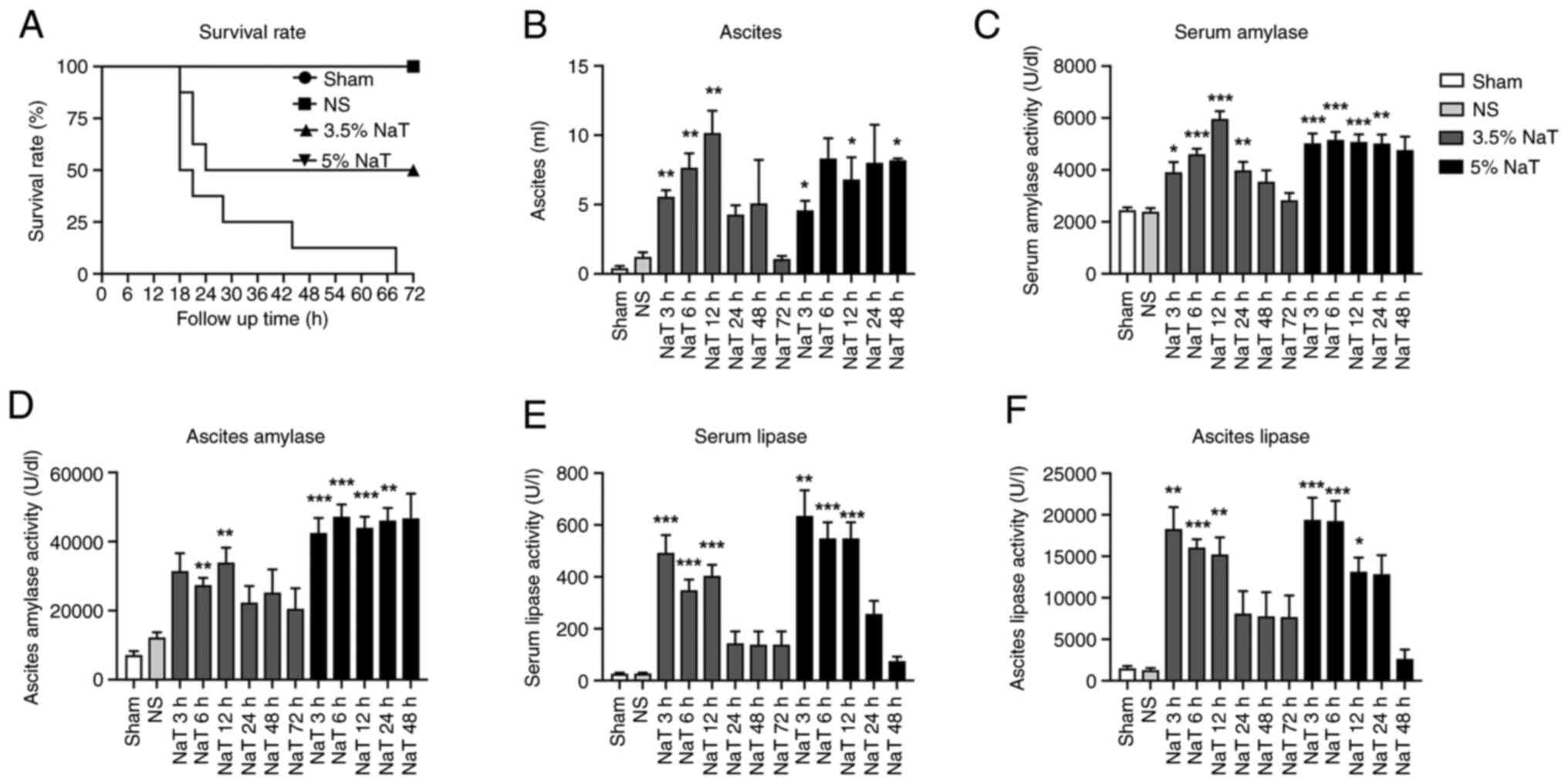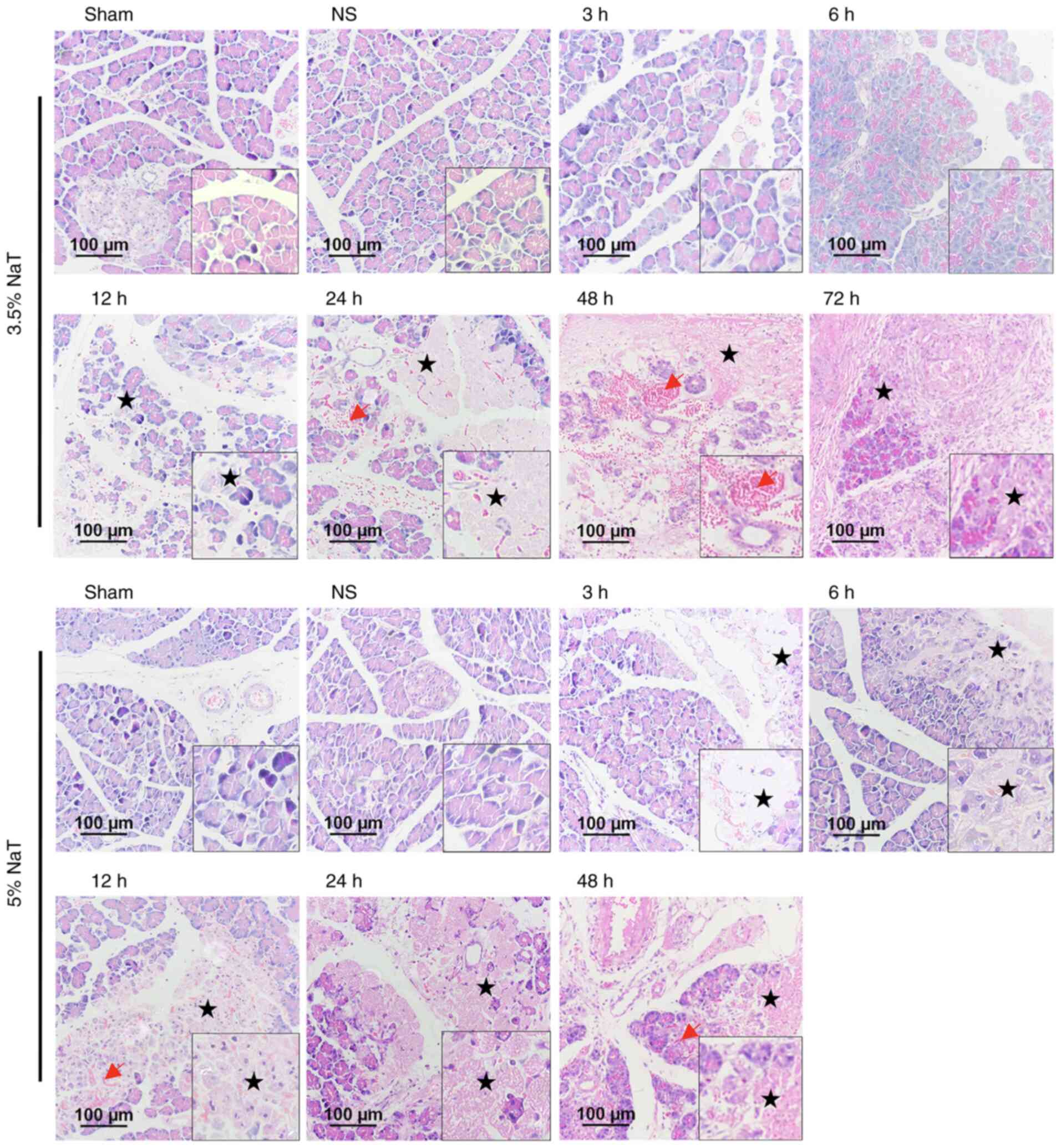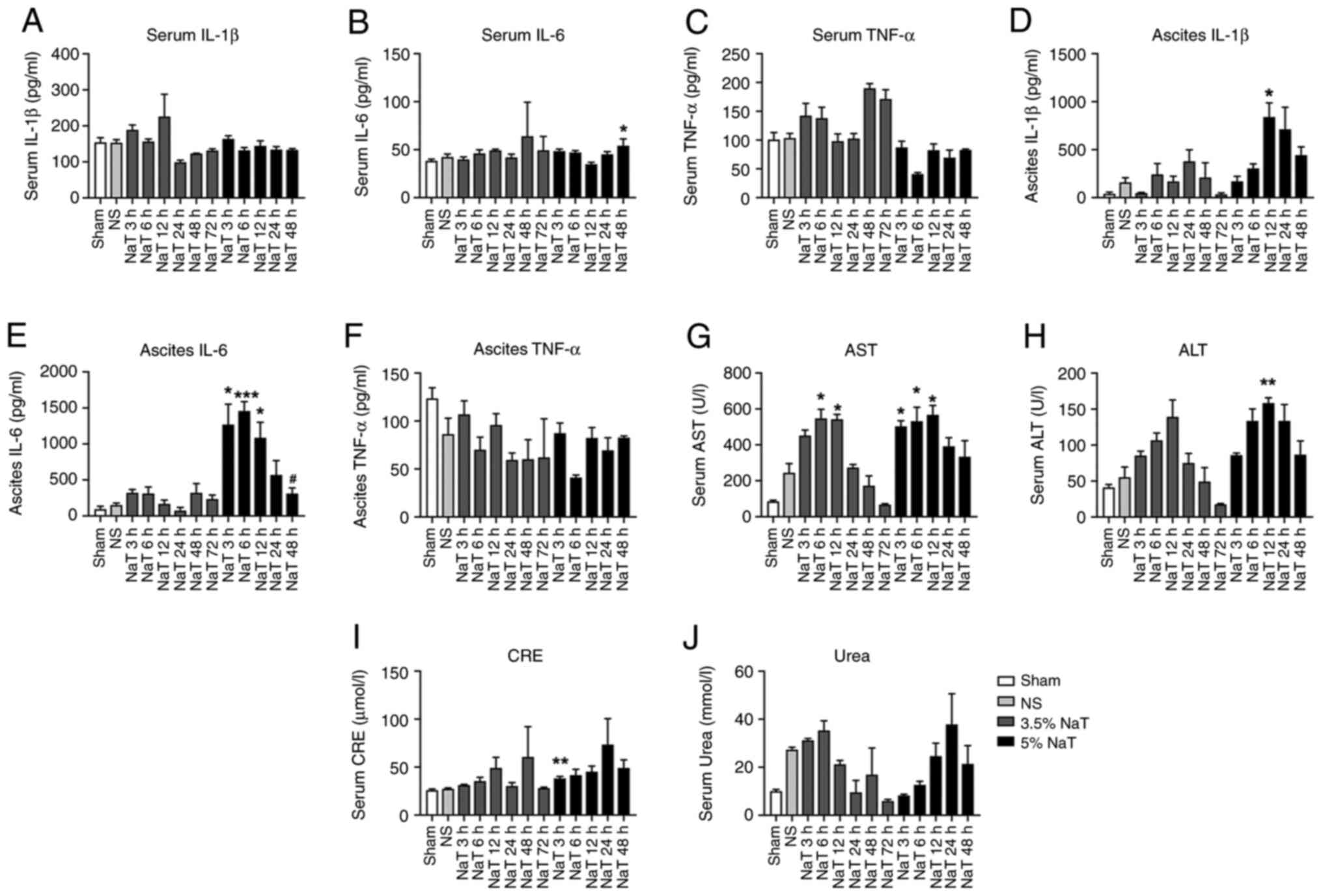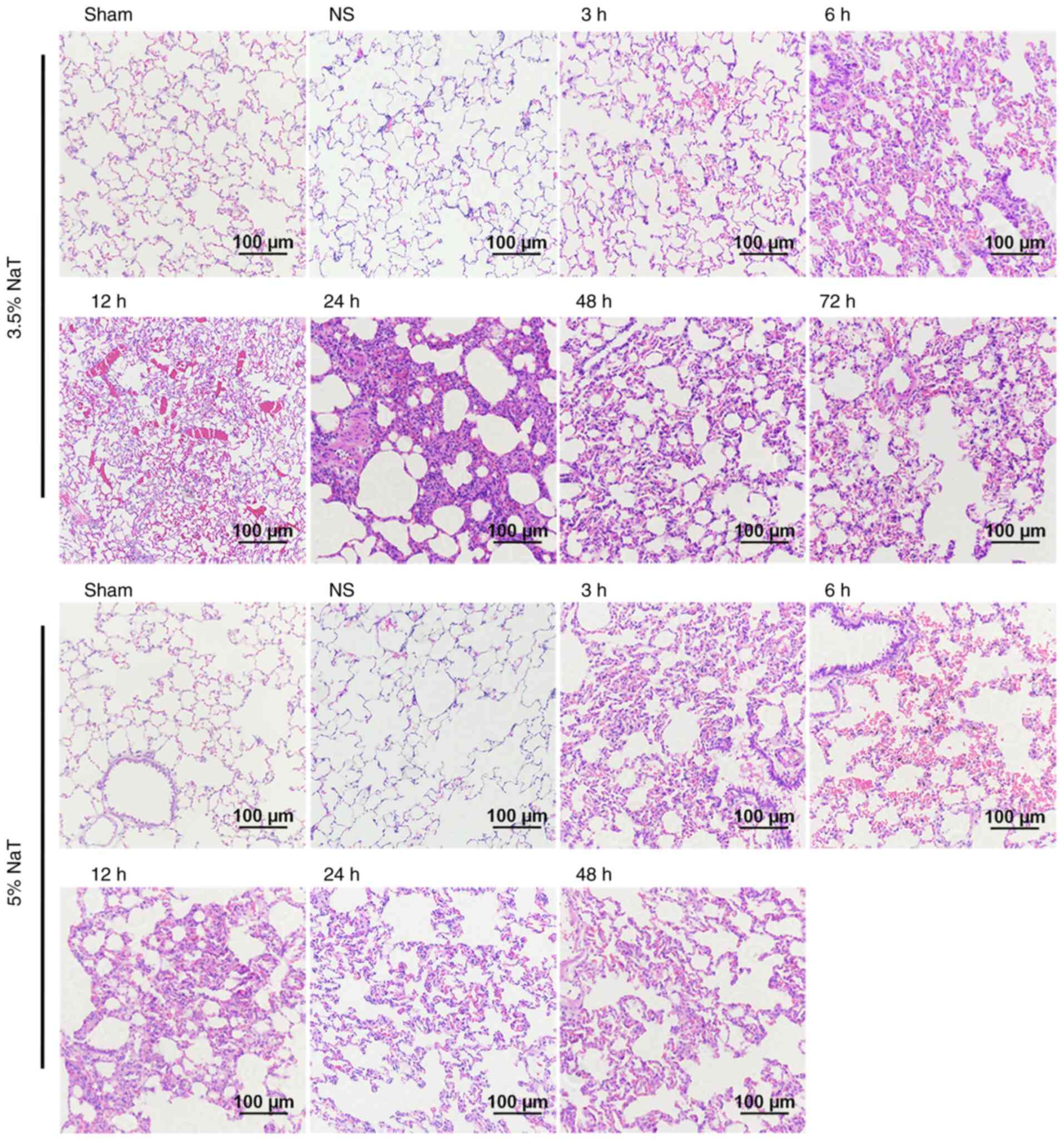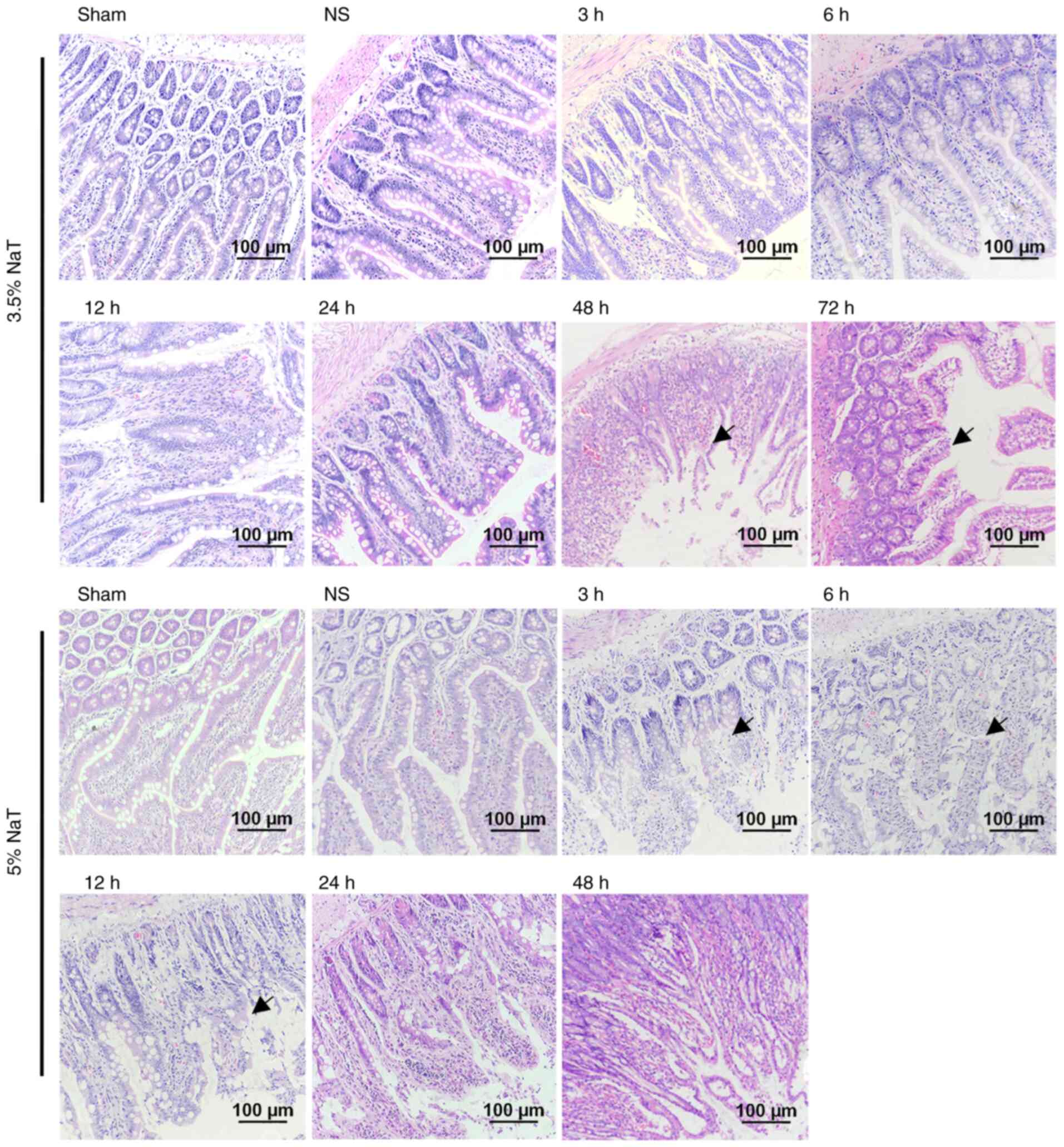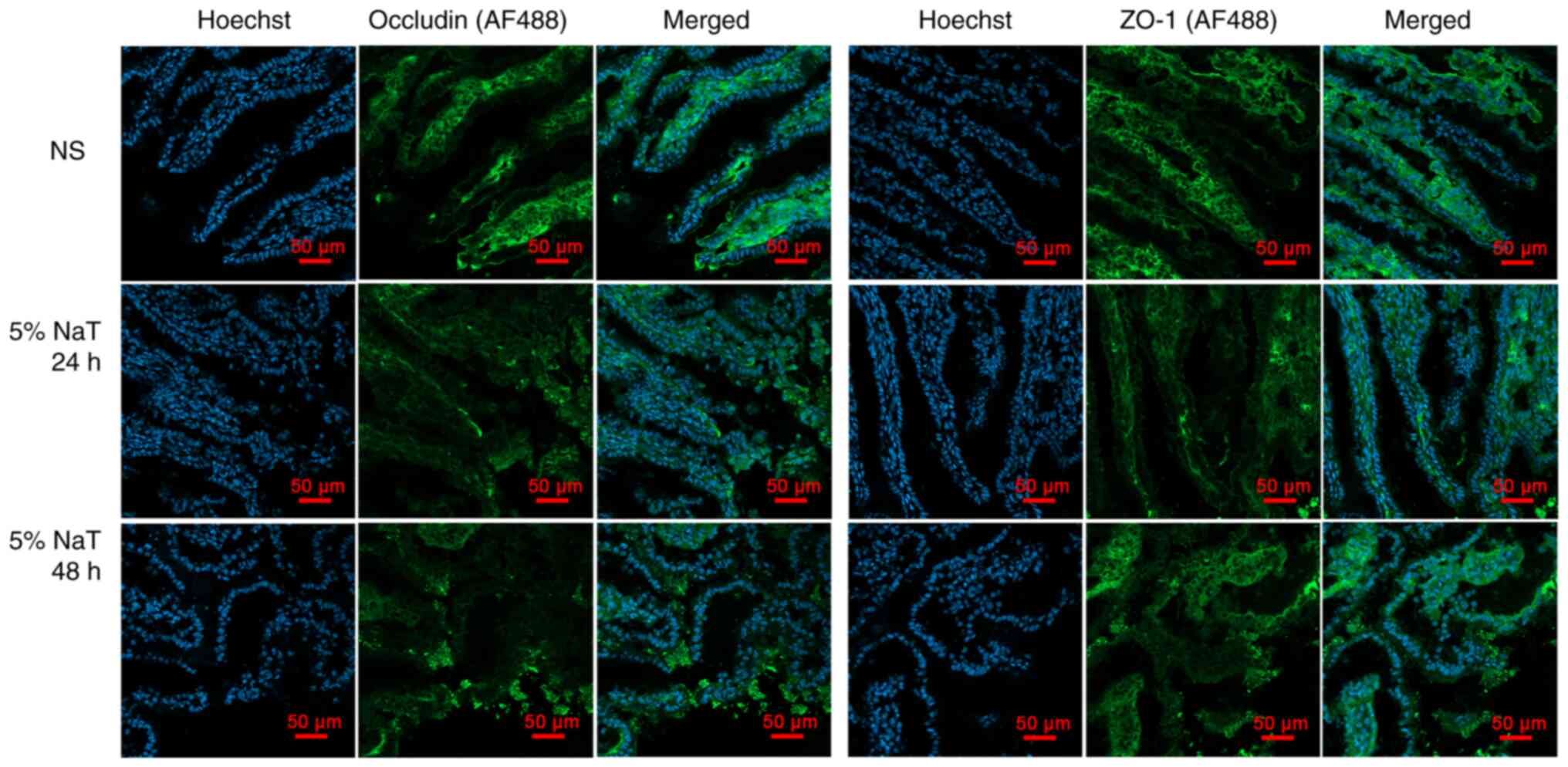|
1
|
Boxhoorn L, Voermans RP, Bouwense SA,
Bruno MJ, Verdonk RC, Boermeester MA, van Santvoort HC and
Besselink MG: Acute pancreatitis. Lancet. 396:726–734.
2020.PubMed/NCBI View Article : Google Scholar
|
|
2
|
Xiao AY, Tan ML, Wu LM, Asrani VM, Windsor
JA, Yadav D and Petrov MS: Global incidence and mortality of
pancreatic diseases: A systematic review, meta-analysis, and
meta-regression of population-based cohort studies. Lancet
Gastroenterol Hepatol. 1:45–55. 2016.PubMed/NCBI View Article : Google Scholar
|
|
3
|
Schepers NJ, Bakker OJ, Besselink MG,
Ahmed Ali U, Bollen TL, Gooszen HG, van Santvoort HC and Bruno MJ:
Dutch Pancreatitis Study Group. Impact of characteristics of organ
failure and infected necrosis on mortality in necrotising
pancreatitis. Gut. 68:1044–1051. 2019.PubMed/NCBI View Article : Google Scholar
|
|
4
|
van Santvoort HC, Bakker OJ, Bollen TL,
Besselink MG, Ahmed Ali U, Schrijver AM, Boermeester MA, van Goor
H, Dejong CH, van Eijck CH, et al: A conservative and minimally
invasive approach to necrotizing pancreatitis improves outcome.
Gastroenterology. 141:1254–1263. 2011.PubMed/NCBI View Article : Google Scholar
|
|
5
|
Bang JY, Wilcox CM, Arnoletti JP and
Varadarajulu S: Superiority of endoscopic interventions over
minimally invasive surgery for infected necrotizing pancreatitis:
Meta-analysis of randomized trials. Dig Endosc. 32:298–308.
2020.PubMed/NCBI View Article : Google Scholar
|
|
6
|
Banks PA, Bollen TL, Dervenis C, Gooszen
HG, Johnson CD, Sarr MG, Tsiotos GG and Vege SS: Acute Pancreatitis
Classification Working Group. Classification of acute
pancreatitis-2012: Revision of the Atlanta classification and
definitions by international consensus. Gut. 62:102–111.
2013.PubMed/NCBI View Article : Google Scholar
|
|
7
|
Moggia E, Koti R, Belgaumkar AP, Fazio F,
Pereira SP, Davidson BR and Gurusamy KS: Pharmacological
interventions for acute pancreatitis. Cochrane Database Syst Rev.
4(CD011384)2017.PubMed/NCBI View Article : Google Scholar
|
|
8
|
Aho HJ and Nevalainen TJ: Experimental
pancreatitis in the rat. Ultrastructure of sodium
taurocholate-induced pancreatic lesions. Scand J Gastroenterol.
15:417–424. 1980.PubMed/NCBI View Article : Google Scholar
|
|
9
|
Aho HJ, Koskensalo SM and Nevalainen TJ:
Experimental pancreatitis in the rat. Sodium taurocholate-induced
acute haemorrhagic pancreatitis. Scand J Gastroenterol. 15:411–416.
1980.PubMed/NCBI View Article : Google Scholar
|
|
10
|
Laukkarinen JM, Van Acker GJ, Weiss ER,
Steer ML and Perides G: A mouse model of acute biliary pancreatitis
induced by retrograde pancreatic duct infusion of Na-taurocholate.
Gut. 56:1590–1598. 2007.PubMed/NCBI View Article : Google Scholar
|
|
11
|
Saluja A, Dudeja V, Dawra R and Sah RP:
Early intra-acinar events in pathogenesis of pancreatitis.
Gastroenterology. 156:1979–1993. 2019.PubMed/NCBI View Article : Google Scholar
|
|
12
|
Su KH, Cuthbertson C and Christophi C:
Review of experimental animal models of acute pancreatitis. HPB
(Oxford). 8:264–286. 2006.PubMed/NCBI View Article : Google Scholar
|
|
13
|
Serra MB, Koike MK, Barbeiro DF, Machado
MCC and de Souza HP: Sodium taurocholate induced severe acute
pancreatitis in C57BL/6 Mice. J Vis Exp. 172(e61547)2021.PubMed/NCBI View
Article : Google Scholar
|
|
14
|
Yang X, Geng H, You L, Yuan L, Meng J, Ma
Y, Gu X and Lei M: Rhein protects against severe acute pancreatitis
in vitro and in vivo by regulating the JAK2/STAT3 pathway. Front
Pharmacol. 13(778221)2022.PubMed/NCBI View Article : Google Scholar
|
|
15
|
Liu ZH, Peng JS, Li CJ, Yang ZL, Xiang J,
Song H, Wu XB, Chen JR and Diao DC: A simple taurocholate-induced
model of severe acute pancreatitis in rats. World J Gastroenterol.
15:5732–5739. 2009.PubMed/NCBI View Article : Google Scholar
|
|
16
|
Guo P, Liu L, Yang X, Li M, Zhao Q and Wu
H: Irisin improves BBB dysfunction in SAP rats by inhibiting MMP-9
via the ERK/NF-κB signaling pathway. Cell Signal.
93(110300)2022.PubMed/NCBI View Article : Google Scholar
|
|
17
|
Qi H, Lu Q, Yin C, Xiao H, Wen Y, Zhang S,
Cui Q and Yang W: Exogenous leptin protects rat models of sodium
taurocholate-induced severe acute pancreatitis through endocrinal
and immunological pathways. Mol Med Rep. 16:6306–6312.
2017.PubMed/NCBI View Article : Google Scholar
|
|
18
|
Guo Q, Li A, Xia Q, Liu X, Tian B, Mai G,
Huang Z, Chen G, Tang W, Jin X, et al: The role of organ failure
and infection in necrotizing pancreatitis: A prospective study. Ann
Surg. 259:1201–1207. 2014.PubMed/NCBI View Article : Google Scholar
|
|
19
|
Garg PK and Singh VP: Organ failure due to
systemic injury in acute pancreatitis. Gastroenterology.
156:2008–2023. 2019.PubMed/NCBI View Article : Google Scholar
|
|
20
|
Johnson CD and Abu-Hilal M: Persistent
organ failure during the first week as a marker of fatal outcome in
acute pancreatitis. Gut. 53:1340–1344. 2004.PubMed/NCBI View Article : Google Scholar
|
|
21
|
Mofidi R, Duff MD, Wigmore SJ, Madhavan
KK, Garden OJ and Parks RW: Association between early systemic
inflammatory response, severity of multiorgan dysfunction and death
in acute pancreatitis. Br J Surg. 93:738–744. 2006.PubMed/NCBI View
Article : Google Scholar
|
|
22
|
Mowbray NG, Ben-Ismaeil B, Hammoda M,
Shingler G and Al-Sarireh B: The microbiology of infected
pancreatic necrosis. Hepatobiliary Pancreat Dis Int. 17:456–460.
2018.PubMed/NCBI View Article : Google Scholar
|
|
23
|
Schmidt J, Rattner DW, Lewandrowski K,
Compton CC, Mandavilli U, Knoefel WT and Warshaw AL: A better model
of acute pancreatitis for evaluating therapy. Ann Surg. 215:44–56.
1992.PubMed/NCBI View Article : Google Scholar
|
|
24
|
Matta B, Gougol A, Gao X, Reddy N,
Talukdar R, Kochhar R, Goenka MK, Gulla A, Gonzalez JA, Singh VK,
et al: Worldwide variations in demographics, management, and
outcomes of acute pancreatitis. Clin Gastroenterol Hepatol.
18:1567–1575.e2. 2020.PubMed/NCBI View Article : Google Scholar
|
|
25
|
Gliem N, Ammer-Herrmenau C, Ellenrieder V
and Neesse A: Management of severe acute pancreatitis: An update.
Digestion. 102:503–507. 2021.PubMed/NCBI View Article : Google Scholar
|
|
26
|
Gapp J, Hoilat GJ and Chandra S:
Pancreatic ascites. In: StatPearls. Treasure Island (FL):
StatPearls Publishing, 2020.
|
|
27
|
Wittel UA, Wiech T, Chakraborty S, Boss B,
Lauch R, Batra SK and Hopt UT: Taurocholate-induced pancreatitis: A
model of severe necrotizing pancreatitis in mice. Pancreas.
36:e9–e21. 2008.PubMed/NCBI View Article : Google Scholar
|
|
28
|
Malmstrøm ML, Hansen MB, Andersen AM,
Ersbøll AK, Nielsen OH, Jørgensen LN and Novovic S: Cytokines and
organ failure in acute pancreatitis: Inflammatory response in acute
pancreatitis. Pancreas. 41:271–277. 2012.PubMed/NCBI View Article : Google Scholar
|
|
29
|
Hirota M, Nozawa F, Okabe A, Shibata M,
Beppu T, Shimada S, Egami H, Yamaguchi Y, Ikei S, Okajima T, et al:
Relationship between plasma cytokine concentration and multiple
organ failure in patients with acute pancreatitis. Pancreas.
21:141–146. 2000.PubMed/NCBI View Article : Google Scholar
|
|
30
|
Brivet FG, Emilie D and Galanaud P: Pro-
and anti-inflammatory cytokines during acute severe pancreatitis:
An early and sustained response, although unpredictable of death.
Parisian study group on acute pancreatitis. Crit Care Med.
27:749–755. 1999.PubMed/NCBI View Article : Google Scholar
|
|
31
|
Sendler M, Maertin S, John D, Persike M,
Weiss FU, Krüger B, Wartmann T, Wagh P, Halangk W, Schaschke N, et
al: Cathepsin B activity initiates apoptosis via digestive protease
activation in pancreatic acinar cells and experimental
pancreatitis. J Biol Chem. 291:14717–14731. 2016.PubMed/NCBI View Article : Google Scholar
|
|
32
|
Sendler M, Weiss FU, Golchert J, Homuth G,
van den Brandt C, Mahajan UM, Partecke LI, Döring P, Gukovsky I,
Gukovskaya AS, et al: Cathepsin B-mediated activation of
trypsinogen in endocytosing macrophages increases severity of
pancreatitis in mice. Gastroenterology. 154:704–718.e10.
2018.PubMed/NCBI View Article : Google Scholar
|
|
33
|
Zhang J, Yu WQ, Wei T, Zhang C, Wen L,
Chen Q, Chen W, Qiu JY, Zhang Y and Liang TB: Effects of
short-peptide-based enteral nutrition on the intestinal
microcirculation and mucosal barrier in mice with severe acute
pancreatitis. Mol Nutr Food Res. 64(e1901191)2020.PubMed/NCBI View Article : Google Scholar
|
|
34
|
de Madaria E, Martínez J, Lozano B,
Sempere L, Benlloch S, Such J, Uceda F, Francés R and Pérez-Mateo
M: Detection and identification of bacterial DNA in serum from
patients with acute pancreatitis. Gut. 54:1293–1297.
2005.PubMed/NCBI View Article : Google Scholar
|
|
35
|
ShaykhoIslami A, Ghasemian M, Zardast M
and Farzad M: Effect of intra-abdominal administration of ascites
fluid on postoperative peritoneal adhesion in rat model: A
randomized controlled trail. Ann Med Surg (Lond).
71(102928)2021.PubMed/NCBI View Article : Google Scholar
|
|
36
|
Baroja-Mazo A, Martín-Sánchez F, Gomez AI,
Martínez CM, Amores-Iniesta J, Compan V, Barberà-Cremades M, Yagüe
J, Ruiz-Ortiz E, Antón J, et al: The NLRP3 inflammasome is released
as a particulate danger signal that amplifies the inflammatory
response. Nat Immunol. 15:738–748. 2014.PubMed/NCBI View Article : Google Scholar
|
|
37
|
Sendler M, van den Brandt C, Glaubitz J,
Wilden A, Golchert J, Weiss FU, Homuth G, De Freitas Chama LL,
Mishra N, Mahajan UM, et al: NLRP3 inflammasome regulates
development of systemic inflammatory response and compensatory
anti-inflammatory response syndromes in mice with acute
pancreatitis. Gastroenterology. 158:253–269.e14. 2020.PubMed/NCBI View Article : Google Scholar
|
|
38
|
Liu RH, Wen Y, Sun HY, Liu CY, Zhang YF,
Yang Y, Huang QL, Tang JJ, Huang CC and Tang LJ: Abdominal
paracentesis drainage ameliorates severe acute pancreatitis in rats
by regulating the polarization of peritoneal macrophages. World J
Gastroenterol. 24:5131–5143. 2018.PubMed/NCBI View Article : Google Scholar
|
|
39
|
Kaukonen KM, Bailey M, Pilcher D, Cooper
DJ and Bellomo R: Systemic inflammatory response syndrome criteria
in defining severe sepsis. N Engl J Med. 372:1629–1638.
2015.PubMed/NCBI View Article : Google Scholar
|
|
40
|
Matsumoto M, Kamei K, Chikugo T, Matsumoto
I, Kawaguchi K and Takeyama Y: Efficacy of recombinant
human-soluble thrombomodulin for severe acute pancreatitis in a rat
experimental model. Pancreas. 49:503–508. 2020.PubMed/NCBI View Article : Google Scholar
|
|
41
|
Rashid MU, Hussain I, Jehanzeb S, Ullah W,
Ali S, Jain AG, Khetpal N and Ahmad S: Pancreatic necrosis:
Complications and changing trend of treatment. World J Gastrointest
Surg. 11:198–217. 2019.PubMed/NCBI View Article : Google Scholar
|
|
42
|
Shi Q, Liao KS, Zhao KL, Wang WX, Zuo T,
Deng WH, Chen C, Yu J, Guo WY, He XB, et al: Hydrogen-rich saline
attenuates acute renal injury in sodium taurocholate-induced severe
acute pancreatitis by inhibiting ROS and NF-κB pathway. Mediators
Inflamm. 2015(685043)2015.PubMed/NCBI View Article : Google Scholar
|
|
43
|
Zhu S, Zhang C, Weng Q and Ye B: Curcumin
protects against acute renal injury by suppressing JAK2/STAT3
pathway in severe acute pancreatitis in rats. Exp Ther Med.
14:1669–1674. 2017.PubMed/NCBI View Article : Google Scholar
|
|
44
|
Zhang XH, Li ML, Wang B, Guo MX and Zhu
RM: Caspase-1 inhibition alleviates acute renal injury in rats with
severe acute pancreatitis. World J Gastroenterol. 20:10457–10463.
2014.PubMed/NCBI View Article : Google Scholar
|
|
45
|
Li YY, Li XL, Yang CX, Zhong H, Yao H and
Zhu L: Effects of tetrandrine and QYT on ICAM-1 and SOD gene
expression in pancreas and liver of rats with acute pancreatitis.
World J Gastroenterol. 9:155–159. 2003.PubMed/NCBI View Article : Google Scholar
|
|
46
|
Stoppacher R: Sudden death due to acute
pancreatitis. Acad Forensic Pathol. 8:239–255. 2018.PubMed/NCBI View Article : Google Scholar
|
|
47
|
Yang A, Zhang L and Vege SS: Autopsy study
of patients dying due to acute pancreatitis: 262. Am Coll
Gastroenterol. 109(S81)2014.
|
|
48
|
Li XY, He C, Zhu Y and Lu NH: Role of gut
microbiota on intestinal barrier function in acute pancreatitis.
World J Gastroenterol. 26:2187–2193. 2020.PubMed/NCBI View Article : Google Scholar
|
|
49
|
Bansal A, Gupta P, Singh H, Samanta J,
Mandavdhare H, Sharma V, Sinha SK, Dutta U and Kochhar R:
Gastrointestinal complications in acute and chronic pancreatitis.
JGH Open. 3:450–455. 2019.PubMed/NCBI View Article : Google Scholar
|
|
50
|
Piao X, Liu B, Sui X, Niu W, Zhang Q, Shi
X, Cai S and Fan Y: Picroside II improves severe acute
pancreatitis-induced intestinal barrier injury by inactivating
oxidative and inflammatory TLR4-dependent PI3K/AKT/NF-κB signaling
and improving gut microbiota. Oxid Med Cell Longev.
2020(3589497)2020.PubMed/NCBI View Article : Google Scholar
|
|
51
|
Su S, Liang T, Zhou X, He K, Li B and Xia
X: Qingyi decoction attenuates severe acute pancreatitis in rats
via inhibition of inflammation and protection of the intestinal
barrier. J Int Med Res. 47:2215–2227. 2019.PubMed/NCBI View Article : Google Scholar
|
|
52
|
Ye J, Dai H, Liu Y, Yu B, Yang J and Fei
A: Blockade of C3a/C3aR axis alleviates severe acute
pancreatitis-induced intestinal barrier injury. Am J Transl Res.
12:6290–6301. 2020.PubMed/NCBI
|
|
53
|
Ning JW, Zhang Y, Yu MS, Gu ML, Xu J,
Usman A and Ji F: Emodin alleviates intestinal mucosal injury in
rats with severe acute pancreatitis via the caspase-1 inhibition.
Hepatobiliary Pancreat Dis Int. 16:431–436. 2017.PubMed/NCBI View Article : Google Scholar
|















